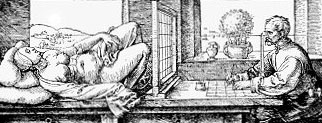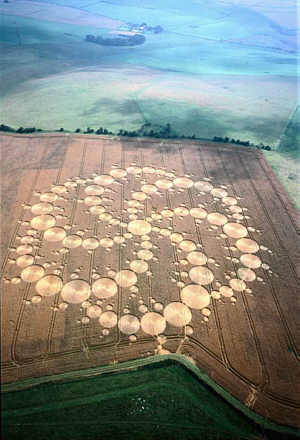Oh, please. First, often many plants *are* disturbed "outside the design itself". You just don't hear about it often because the media can sell more papers by playing up the "Twilight Zone" aspect (and because crop circle fans aren't prone to admit details that could undercut the "it's aliens, I tell you!" position).
But as for what can be done with simple tools, anyone with a basic Geometry background knows that you can construct almost any pattern with great precision using nothing more than a straightedge (e.g. rope stretched between two points) and a compass (e.g. measured length of rope held fixed at one point while the other end is swung in a circle). Just plan out the design on paper in advance, then prepare a list of the appropriate measurements and "constructors" before you head out to the field.
Another method that can be used to reproduce any arbitrary design, no matter how complicated, is to draw it first (or print it from the computer) onto graph paper. Each square becomes a measured plot of ground (all you need is a ruler), in which you bend the crops in an approximation of the part of the pattern that overlaps that square on the "chart". This is often used by beginning artists, and is known as the "grid method" -- it even works great for reproducing 3D subjects, as seen below:




And plow/plant lines make great landmarks for keeping the grid lines straight.
Neither of these methods requires any tools or techniques not available to the ancient Egyptians, or the folks who made the Nazca lines.
Variations include constructing pre-measured angles on the blueprint using measured distances from a baseline, a feature produced in steps 1-(N-1), or sticks set into place as foundation markers (then removed and their holes covered up when finished).
Furthermore, the "geometric precision" of crop circles is often overstated. For example, consider this one:

Wow, looks too perfect to be manmade, right? But look again...
First, keep in mind that squashing a circle into the crops is easy -- hold one end of a rope where you want the center to be, then just carry the other end around the fixed end while keeping rope taught -- just like using a compass in drafting.
So the only "difficult" part of this pattern is positioning the circles themselves. It looks precise at first glance, but the more you look the more the flaws stand out. For example, each "arm" is made of thirteen circles. Well, except for the one that radiates out from the "10 o'clock" position and ends at the top. It's got *twelve* circles. Oops. The one next to it, that starts at the "12 o'clock" position, has thirteen circles, but the last one is extremely "stunted" because the pranksters misjudged the earlier circles' positions/sizes and ran out of room. And there are a *lot* of irregularities in the positions of the smaller "satellite" circles". Also note that the "arms" themselves are laid out in nice semi-circular arcs. Again, flattening a circle or laying out a circular path is quite easy using any variety of methods -- even methods that have the restriction that you must stay "on" the arc itself at all times, and not take up position at the circle's center. So the "difficulty level" of this pattern isn't nearly as great as it appears at first glance.
Similarly, the following "complex" pattern turns out to be pretty simple to construct:

Looks fancy, until you realize that every arc in the design is simply made up of -- overlapping circles. And again, the more you look at the design, the more irregularities you'll see -- the overlapped circles aren't positioned exactly right, and thus the spaces between them are irregular in size and shape.
Finally, handheld GPS devices have been available for a long time now (since 1989), and the production of any arbitrarily complex crop design would be made trivial using preselected GPS coordinates.
And all this is accomplished without being noticed, spending hours with flashlights in a field.
Contrary to popular belief, after working hard all day, farmers don't make a habit of staying up all night looking out over their fields. Nor do night-owls traveling the roads in the middle of the night out in farm country generally bother to go investigate an unremarkable and faint distant light (if they can see them at all over the top of the crops).
I don't doubt that some pranksters have been discovered in the act, but it's unremarkable that most manage to pull it off without notice.